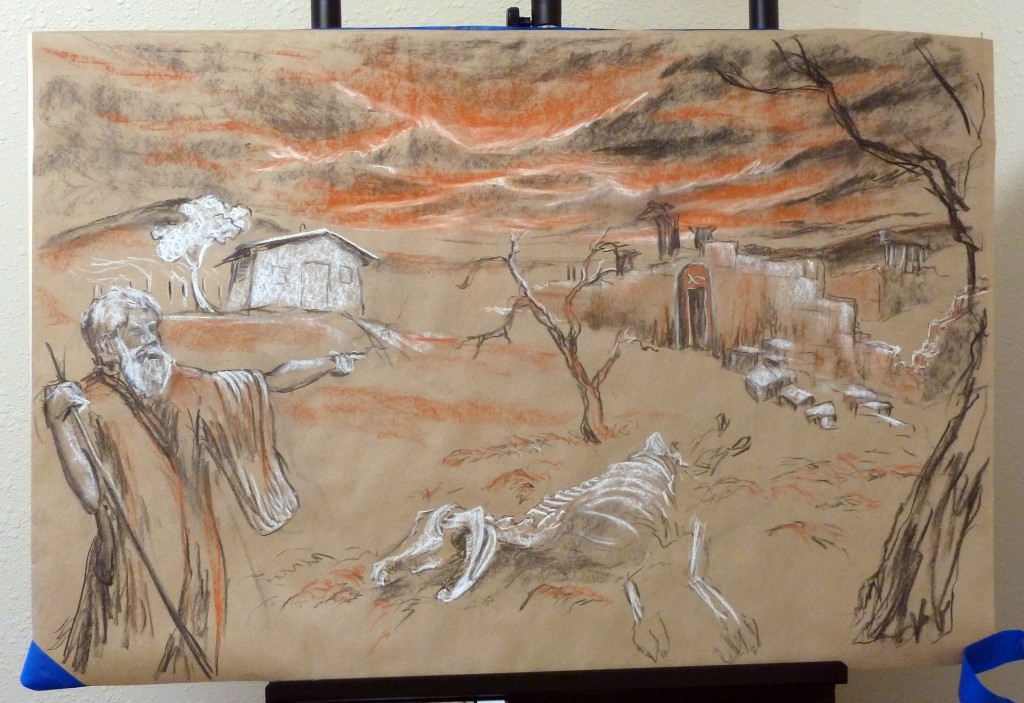After our Easter services yesterday, we got into a discussion comparing the Easter hymns in Lift Up Your Hearts to those in the gray Psalter Hymnal. Here’s the upshot:
The gray Psalter Hymnal contained 19 hymns in its Easter section. Of these 10 can be found in the Easter section of Lift Up Your Hearts:
“Alleluia! Alleluia! Hearts to Heaven” (LUYH #197/PH87 #387/PH57 #360)
“Christ the Lord Is Risen Today” (LUYH #182/PH87 #388/PH57 #356/SWM #132/HFW #81)
“Good Christians All, Rejoice and Sing” (LUYH #184/PH87 #397/HFW #208)
“The Strife Is O’er, the Battle Done” (LUYH #185/PH87 #391/PH57 #358/HFW #71)
“Low in the Grave Christ Lay” (LUYH #186/PH87 #396/PH57 #357/HWF #187)
“O Sons and Daughters” (LUYH #190/PH87 #393/SNT #107)
“Praise the Savior Now and Ever” (LUYH #191/PH87 #400/PH57 #361/HFW #29)
“Oh, Qué Bueno Es Jesús/O, How Good Is Christ the Lord” (LUYH #192/PH87 #401)
“Come, You Faithful, Raise the Strain” (LUYH #199/PH87 #389/PH57 #362/HFW #34)
“This Joyful Eastertide” (LUYH #202/PH87 #402/HWF #163)
“I Serve a Risen Savior” (LUYH #365/PH87 #404/HFW #214) is found in Lift Up Your Hearts in the Trusting the Triune God in Grateful Living section.
These strike me as good choices. Today we sang “I Serve a Risen Savior” at our sunrise service and “Low in the Grave Christ Lay” and “Christ the Lord Is Risen Today” at our regular service. I expect we’ll sing several more of these during Easter season. (The only one with which I am unfamiliar is “O Sons and Daughters.”)
Eight of the songs were dropped from LUYH. Two of these appeared on my list of notable hymns omitted from the new hymnal:
“Sing, Choirs of New Jerusalem” (PH87 #403)
“Hail, O Once-Despised Jesus” (PH87 #395/PH57 #369)
The only other two I recall singing at Trinity are:
“A Shout Rings Out, a Joyful Voice/Daar juicht een toon” (PH87 #392).
“Alleluia, Alleluia! Give Thanks” (PH87 #402/HFW #229/SWM #129)
The other four are:
“The Day of Resurrection” (PH87 #390/PH57 #364)
“These Things Did Thomas Count as Real” (PH87 #394)
“Christ Jesus Lay in Death’s Strong Bonds” (PH87 #398/HFW #47)
“Jesus Lives, and So Do We” (PH87 #399)
So what’s new to the Lift Up Your Hearts Easter section?
Three songs were moved there from other sections in the gray Psalter Hymnal.
“Christ Is Alive! Let Christians Sing” (LUYH #206/PH87 #413) was in the Ascension and Reign section of the gray Psalter Hymnal. The lyrics have been revised by the composer, Brian Wren. Stanza 1 (“Christ is alive! Let Christians sing…”) is the same. Stanza 2 (“Christ is alive! No longer bound…”) has been altered, e.g., “conquer every place and time” becomes “touching every place and time.” The third stanza in the Psalter Hymnal (“Not decked with gold, remotely high…”) is now gone. The next stanza (“In every insult, rift and war…”) is revised. LUYH’s fourth stanza (“Women and men, in age and youth…”) is new. The final stanza (“Christ is alive, and come to bring…) is almost entirely rewritten. We sang this hymn during our Easter service.
“Alleluia” (LUYH #189/PH87 #639) is a Taizé alleluia by Jacques Berthier.
“Give Thanks to God for All His Goodness” (PFAS #118H/LUYH #196/PH87 #118) is a setting of Psalm 118.
Five of LUYH’s Easter songs appeared in Sing! A New Creation: Two of these we sang during our Easter service:
“Christ Is Risen! Shout Hosanna” (LUYH #204/SNC #147) has lyrics by Brian Wren set to Beethoven’s ODE TO JOY. The version of the hymn in Sing! A New Creation sets the same lyrics to W ZLOBIE LEZY (“Infant Holy, Infant Lowly”).
Christ is risen! Shout hosanna!
Celebrate this day of days!
Christ is risen! Hush in wonder; all creation is amazed.
In the desert all surrounding,
see, a spreading tree has grown.
Healing leaves of grace abounding
bring a taste of love unknown.
“Alleluia! Jesus Is Risen” (LUYH #205/SNC #150) is set to EARTH AND ALL STARS with lyrics by “Earth and All Stars” lyricist Herbert Brokering.
Alleluia! Jesus is risen!
Trumpets resounding in glorious light!
Splendor, the Lamb, heaven forever!
Oh, what a miracle God has in sight!
Jesus has risen and we shall arise;
give God the glory! Alleluia!
The three other songs from Sing! A New Creation are:
“Come to Us, Beloved Stranger” (LUYH #207/SNC #) is based on the Road to Emmaus story and set to BEACH SPRING. I expect we’ll sing it during the Third Sunday of Easter when that story is the gospel lesson.
“Aleluya/Alleluia” (LUYH #183/SNC #149) is a Honduran alleluia arranged by John Bell for the Iona Community.
“Celtic Alleluia” (LUYH #198) is just the chorus of the “Celtic Alleluia” (SNC #148) in Sing! A New Creation.
Eight songs in Lift Up Your Hearts Easter section appeared in neither the gray Psalter Hymnal nor Sing! A New Creation. Two of these are Psalm settings:
“Refuge and Rock” (LUYH #194/PFAS #18A) is a setting of Psalm 18 set to EARTH AND ALL STARS. Here is sample.
“Praise the Lord, the Day Is Won” (LUYH #200/PFAS #105C) is a setting of Psalm 105 (lyrics by Michael Morgan) sung to the tune of “Come, You Faithful, Raise the Strain.” (It is set to a different tune in Psalms for All Seasons.)
The other six new songs are:
“I Know that My Redeemer Lives” (LUYH #193/HFW #108) is set to DUKE STREET (“Jesus Shall Reign”). Here is a sample.
“Thine is the Glory” (LUYH #187/HFW #161) is set to Handel’s JUDAS MACCABAEUS, which was used in the Psalter Hymnal for “Praised Be the Father” (PH87 #582).
“See, What a Morning” (LUYH #181) is a modern hymn by Keith Getty and Stuart Townend. I’m planning on using this in an upcoming service.
“Mfurahini, haleluya/Christ Has Arisen, Alleluia” (LUYH #188) is a Tanzanian song that appeared in Global Songs for Worship. (It is one of 28 song from that book to appear in LUYH.) We’ve sung it at Trinity. Here is a sample.
“Christo Vive/Christ Is Risen” (LUYH #197) is by Argentinian composer Nicolás Martínez.
“Now the Green Blade Rises” (LUYH #203) is a traditional French carol.


